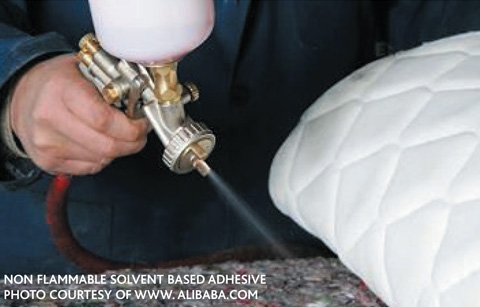John Guthrie draws a comparison between water-based and solvent-based adhesives and gives a few handy tips on adhesive selection.
John Guthrie draws a comparison between water-based and solvent-based adhesives and gives a few handy tips on adhesive selection.
Selecting the right adhesive is an important aspect of a ducting job. The broad options are: water-based and solvent-based adhesives. There are several factors that need to be kept in mind when you compare the two types of adhesives. The difference in VOCs, the thaw cycles, bonding times, application and region are factors which play an important role in ducting and need to be considered while selecting the most suitable product for the job. Choosing the right adhesive can lower application time and decrease installed cost.
Water-based adhesives versus solvent-based adhesives
By viewing the two product bases, you can observe that the level of VOCs vary significantly from several hundred grammes per litre in solvent-based adhesives to under 100 grammes in water-based ones. Water-based adhesives go through a five freeze thaw cycle test in which the product can freeze up to five times and still continue to be useful. When analysing the two products, we need to be aware of the climate of the region in which the product is going to be used. Solvent-based adhesives will adhere easily in more humid climates compared to water-based adhesives, which will take longer to fix on the duct. However, one advantage a water-based adhesive has over a solvent-based one is that it is not flammable. Consequently, one need not worry overmuch about how to store the product or about precautionary measures in case of a fire.
There are quick-setting water-based adhesives that are significantly low in VOCs. These non-flammable adhesives have a faster bonding time, which make them very useful when applying the adhesive on L-shaped duct sections. But this comes with a caveat. One needs to be aware of the true chemical makeup of each adhesive. This implies that you need to review the MSDS sheets for each product looking for “exempt” solvents, as this could make the product hazardous for the applicator while disguised as being “environmentally friendly.” It is, therefore, important to always request for a full disclosure about the chemicals used in the adhesives.
Adhesive selection
An important factor to be noted while choosing an adhesive is that there are certain codes and certifications that are necessary before an adhesive can be applied. For example, ASTM C916 is a testing procedure in which glue is applied to the ductwork, and then put in an oven at 150ºC for 90 days. This test shows that the glue can withstand variable amounts of heat for any number of days.
The SMACNA “HVAC Duct Construction Standard” requires that the adhesive must be applied to 90% of the insulation’s surface. Also, any duct eight inches wide or more requires a mechanical fastener to help secure the insulation.
Choosing the right adhesive is of paramount importance for a successful and sustainable HVAC installation. The right product and the right base can save you time, money and avoid a costly call-back. Be informed about the finer points of the adhesives you use. And remember, though there may be differences in products, there is a right adhesive for every job.
The writer is Regional Sales Manager, Carlisle HVAC. He can be contacted at john.guthrie@ carlislehvac.com

Copyright © 2006-2025 - CPI Industry. All rights reserved.